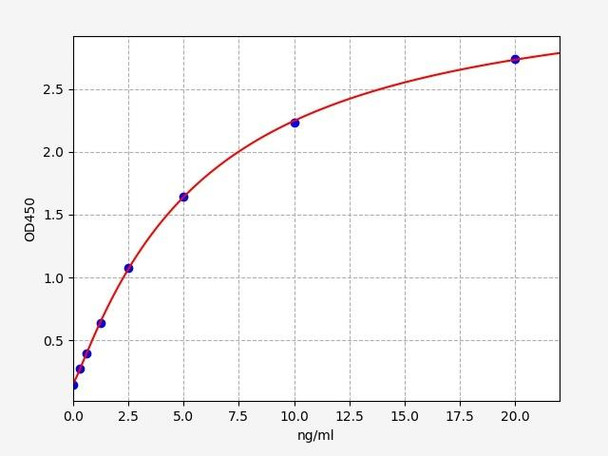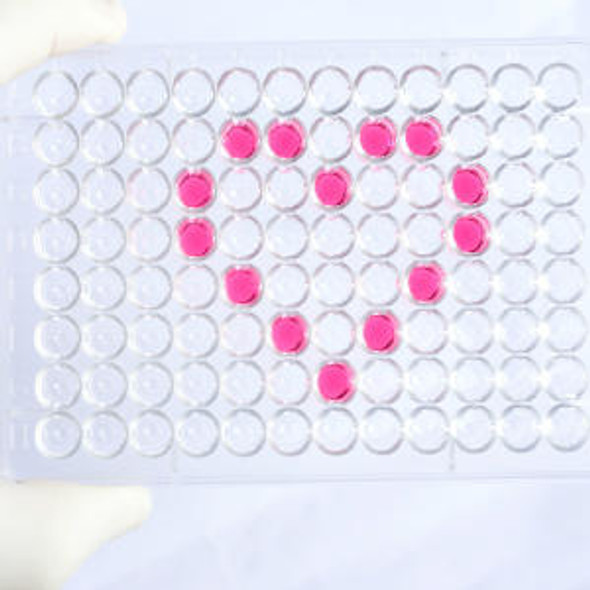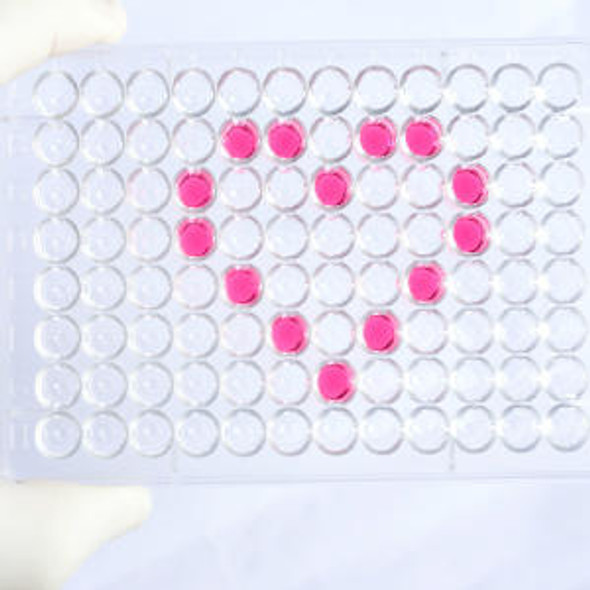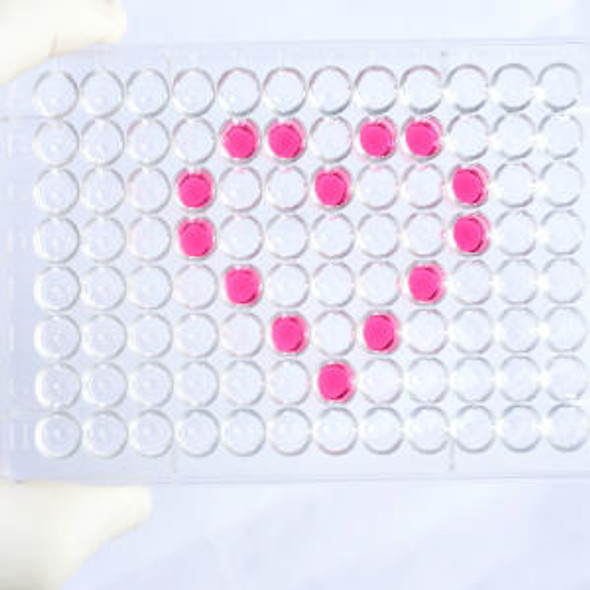Human Low-density lipoprotein receptor-related protein 4 / LRP4 ELISA Kit
- SKU:
- HUFI00985
- Product Type:
- ELISA Kit
- Size:
- 96 Assays
- Uniprot:
- O75096
- Sensitivity:
- 0.188ng/ml
- Range:
- 0.313-20ng/ml
- ELISA Type:
- Sandwich ELISA, Double Antibody
- Synonyms:
- LRP4, Low-density lipoprotein receptor-related protein 4, LRP10, LRP-4, MEGF7, CLSS, low density lipoprotein receptor-related protein 4, Multiple epidermal growth factor-like domains 7
- Reactivity:
- Human
Description
Human Low-density lipoprotein receptor-related protein 4 / LRP4 ELISA Kit
LRP4 may be a Wnt signaling regulator. Cenani-Lenz Syndactyly Syndrome and Myasthenic Syndrome are examples of LRP4-related disorders. The Assay Genie LRP4 ELISA is a highly sensitive assay for the quantitative measurement of LRP4 in serum, blood, plasma, cell culture supernatant and tissue samples.
| Product Name: | Human Low-density lipoprotein receptor-related protein 4 / LRP4 ELISA Kit |
| Product Code: | HUFI00985 |
| Size: | 96 Assays |
| Alias: | LRP4, Low-density lipoprotein receptor-related protein 4, LRP10, LRP-4, MEGF7, CLSS, low density lipoprotein receptor-related protein 4, Multiple epidermal growth factor-like domains 7 |
| Detection method: | Sandwich ELISA, Double Antibody |
| Application: | This immunoassay kit allows for the in vitro quantitative determination of Human LRP4 concentrations in serum plasma and other biological fluids. |
| Sensitivity: | 0.188ng/ml |
| Range: | 0.313-20ng/ml |
| Storage: | 4°C for 6 months |
| Note: | For Research Use Only |
| Recovery: | Matrices listed below were spiked with certain level of Human LRP4 and the recovery rates were calculated by comparing the measured value to the expected amount of Human LRP4 in samples. | ||||||||||||||||
| |||||||||||||||||
| Linearity: | The linearity of the kit was assayed by testing samples spiked with appropriate concentration of Human LRP4 and their serial dilutions. The results were demonstrated by the percentage of calculated concentration to the expected. | ||||||||||||||||
| |||||||||||||||||
| CV(%): | Intra-Assay: CV<8% Inter-Assay: CV<10% |
| Component | Quantity | Storage |
| ELISA Microplate (Dismountable) | 8×12 strips | 4°C for 6 months |
| Lyophilized Standard | 2 | 4°C/-20°C |
| Sample/Standard Dilution Buffer | 20ml | 4°C |
| Biotin-labeled Antibody(Concentrated) | 120ul | 4°C (Protect from light) |
| Antibody Dilution Buffer | 10ml | 4°C |
| HRP-Streptavidin Conjugate(SABC) | 120ul | 4°C (Protect from light) |
| SABC Dilution Buffer | 10ml | 4°C |
| TMB Substrate | 10ml | 4°C (Protect from light) |
| Stop Solution | 10ml | 4°C |
| Wash Buffer(25X) | 30ml | 4°C |
| Plate Sealer | 5 | - |
Other materials and equipment required:
- Microplate reader with 450 nm wavelength filter
- Multichannel Pipette, Pipette, microcentrifuge tubes and disposable pipette tips
- Incubator
- Deionized or distilled water
- Absorbent paper
- Buffer resevoir
| Uniprot | O75096 |
| UniProt Protein Function: | LRP4: Mediates SOST-dependent inhibition of bone formation. Functions as a specific facilitator of SOST-mediated inhibition of Wnt signaling. Plays a key role in the formation and the maintenance of the neuromuscular junction (NMJ), the synapse between motor neuron and skeletal muscle. Directly binds AGRIN and recruits it to the MUSK signaling complex. Mediates the AGRIN- induced phosphorylation of MUSK, the kinase of the complex. The activation of MUSK in myotubes induces the formation of NMJ by regulating different processes including the transcription of specific genes and the clustering of AChR in the postsynaptic membrane. Alternatively, may be involved in the negative regulation of the canonical Wnt signaling pathway, being able to antagonize the LRP6-mediated activation of this pathway. More generally, has been proposed to function as a cell surface endocytic receptor binding and internalizing extracellular ligands for degradation by lysosomes. Defects in LRP4 are the cause of Cenani-Lenz syndactyly syndrome (CLSS). It is a congenital malformation syndrome defined as complete and complex syndactyly of the hands combined with malformations of the forearm bones and similar manifestations in the lower limbs. Defects in LRP4 are the cause of sclerosteosis type 2 (SOST2). A sclerosing bone dysplasia characterized by a generalized hyperostosis and sclerosis leading to a markedly thickened skull, with mandible, ribs, clavicles and all long bones also being affected. Due to narrowing of the foramina of the cranial nerves, facial nerve palsy, hearing loss and atrophy of the optic nerves can occur. Sclerosteosis is clinically and radiologically very similar to van Buchem disease, mainly differentiated by hand malformations and a large stature in sclerosteosis patients. Belongs to the LDLR family. |
| UniProt Protein Details: | Protein type:Receptor, misc.; Membrane protein, integral; Cell surface Chromosomal Location of Human Ortholog: 11p11.2 Cellular Component: cell surface; cell soma; dendrite; postsynaptic density; integral to membrane; flotillin complex; neuromuscular junction Molecular Function:protein binding; protein homodimerization activity; apolipoprotein binding; calcium ion binding; receptor tyrosine kinase binding Biological Process: limb development; extracellular matrix organization and biogenesis; regulation of protein amino acid phosphorylation; Wnt receptor signaling pathway; dendrite morphogenesis; endocytosis; odontogenesis of dentine-containing teeth; dorsal/ventral pattern formation; synaptic growth at neuromuscular junction; hair follicle development; negative regulation of ossification; synapse organization and biogenesis; protein heterotetramerization; negative regulation of axonogenesis; embryonic digit morphogenesis; kidney development; proximal/distal pattern formation Disease: Myasthenic Syndrome, Congenital, 17; Cenani-lenz Syndactyly Syndrome; Sclerosteosis 2 |
| NCBI Summary: | This gene encodes a member of the low-density lipoprotein receptor-related protein family. The encoded protein may be a regulator of Wnt signaling. Mutations in this gene are associated with Cenani-Lenz syndrome. [provided by RefSeq, May 2010] |
| UniProt Code: | O75096 |
| NCBI GenInfo Identifier: | 157384998 |
| NCBI Gene ID: | 4038 |
| NCBI Accession: | NP_002325.2 |
| UniProt Secondary Accession: | O75096,Q4AC85, Q5KTZ5, B2RN39, |
| UniProt Related Accession: | O75096 |
| Molecular Weight: | 212,045 Da |
| NCBI Full Name: | low-density lipoprotein receptor-related protein 4 |
| NCBI Synonym Full Names: | low density lipoprotein receptor-related protein 4 |
| NCBI Official Symbol: | LRP4 |
| NCBI Official Synonym Symbols: | CLSS; LRP-4; LRP10; MEGF7; SOST2 |
| NCBI Protein Information: | low-density lipoprotein receptor-related protein 4; multiple epidermal growth factor-like domains 7 |
| UniProt Protein Name: | Low-density lipoprotein receptor-related protein 4 |
| UniProt Synonym Protein Names: | Multiple epidermal growth factor-like domains 7 |
| Protein Family: | Low-density lipoprotein receptor-related protein |
| UniProt Gene Name: | LRP4 |
| UniProt Entry Name: | LRP4_HUMAN |
*Note: Protocols are specific to each batch/lot. For the correct instructions please follow the protocol included in your kit.
Before adding to wells, equilibrate the SABC working solution and TMB substrate for at least 30 min at 37°C. When diluting samples and reagents, they must be mixed completely and evenly. It is recommended to plot a standard curve for each test.
| Step | Protocol |
| 1. | Set standard, test sample and control (zero) wells on the pre-coated plate respectively, and then, record their positions. It is recommended to measure each standard and sample in duplicate. Wash plate 2 times before adding standard, sample and control (zero) wells! |
| 2. | Aliquot 0.1ml standard solutions into the standard wells. |
| 3. | Add 0.1 ml of Sample / Standard dilution buffer into the control (zero) well. |
| 4. | Add 0.1 ml of properly diluted sample ( Human serum, plasma, tissue homogenates and other biological fluids.) into test sample wells. |
| 5. | Seal the plate with a cover and incubate at 37 °C for 90 min. |
| 6. | Remove the cover and discard the plate content, clap the plate on the absorbent filter papers or other absorbent material. Do NOT let the wells completely dry at any time. Wash plate X2. |
| 7. | Add 0.1 ml of Biotin- detection antibody working solution into the above wells (standard, test sample & zero wells). Add the solution at the bottom of each well without touching the side wall. |
| 8. | Seal the plate with a cover and incubate at 37°C for 60 min. |
| 9. | Remove the cover, and wash plate 3 times with Wash buffer. Let wash buffer rest in wells for 1 min between each wash. |
| 10. | Add 0.1 ml of SABC working solution into each well, cover the plate and incubate at 37°C for 30 min. |
| 11. | Remove the cover and wash plate 5 times with Wash buffer, and each time let the wash buffer stay in the wells for 1-2 min. |
| 12. | Add 90 µl of TMB substrate into each well, cover the plate and incubate at 37°C in dark within 10-20 min. (Note: This incubation time is for reference use only, the optimal time should be determined by end user.) And the shades of blue can be seen in the first 3-4 wells (with most concentrated standard solutions), the other wells show no obvious color. |
| 13. | Add 50 µl of Stop solution into each well and mix thoroughly. The color changes into yellow immediately. |
| 14. | Read the O.D. absorbance at 450 nm in a microplate reader immediately after adding the stop solution. |
When carrying out an ELISA assay it is important to prepare your samples in order to achieve the best possible results. Below we have a list of procedures for the preparation of samples for different sample types.
| Sample Type | Protocol |
| Serum | If using serum separator tubes, allow samples to clot for 30 minutes at room temperature. Centrifuge for 10 minutes at 1,000x g. Collect the serum fraction and assay promptly or aliquot and store the samples at -80°C. Avoid multiple freeze-thaw cycles. If serum separator tubes are not being used, allow samples to clot overnight at 2-8°C. Centrifuge for 10 minutes at 1,000x g. Remove serum and assay promptly or aliquot and store the samples at -80°C. Avoid multiple freeze-thaw cycles. |
| Plasma | Collect plasma using EDTA or heparin as an anticoagulant. Centrifuge samples at 4°C for 15 mins at 1000 × g within 30 mins of collection. Collect the plasma fraction and assay promptly or aliquot and store the samples at -80°C. Avoid multiple freeze-thaw cycles. Note: Over haemolysed samples are not suitable for use with this kit. |
| Urine & Cerebrospinal Fluid | Collect the urine (mid-stream) in a sterile container, centrifuge for 20 mins at 2000-3000 rpm. Remove supernatant and assay immediately. If any precipitation is detected, repeat the centrifugation step. A similar protocol can be used for cerebrospinal fluid. |
| Cell culture supernatant | Collect the cell culture media by pipette, followed by centrifugation at 4°C for 20 mins at 1500 rpm. Collect the clear supernatant and assay immediately. |
| Cell lysates | Solubilize cells in lysis buffer and allow to sit on ice for 30 minutes. Centrifuge tubes at 14,000 x g for 5 minutes to remove insoluble material. Aliquot the supernatant into a new tube and discard the remaining whole cell extract. Quantify total protein concentration using a total protein assay. Assay immediately or aliquot and store at ≤ -20 °C. |
| Tissue homogenates | The preparation of tissue homogenates will vary depending upon tissue type. Rinse tissue with 1X PBS to remove excess blood & homogenize in 20ml of 1X PBS (including protease inhibitors) and store overnight at ≤ -20°C. Two freeze-thaw cycles are required to break the cell membranes. To further disrupt the cell membranes you can sonicate the samples. Centrifuge homogenates for 5 mins at 5000xg. Remove the supernatant and assay immediately or aliquot and store at -20°C or -80°C. |
| Tissue lysates | Rinse tissue with PBS, cut into 1-2 mm pieces, and homogenize with a tissue homogenizer in PBS. Add an equal volume of RIPA buffer containing protease inhibitors and lyse tissues at room temperature for 30 minutes with gentle agitation. Centrifuge to remove debris. Quantify total protein concentration using a total protein assay. Assay immediately or aliquot and store at ≤ -20 °C. |
| Breast Milk | Collect milk samples and centrifuge at 10,000 x g for 60 min at 4°C. Aliquot the supernatant and assay. For long term use, store samples at -80°C. Minimize freeze/thaw cycles. |










